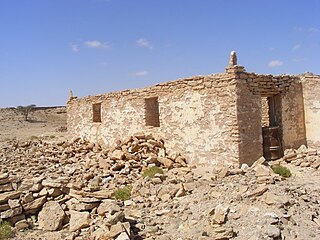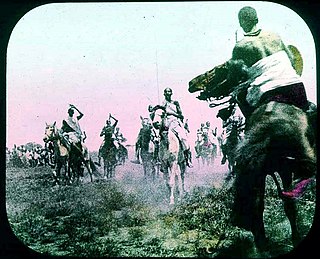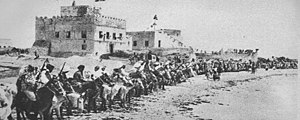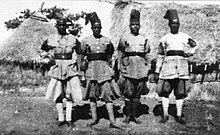
Italian Somalia, was a protectorate and later colony of the Kingdom of Italy in present-day Somalia. Ruled in the 19th century by the Somali Sultanates of Hobyo and Majeerteen in the north, and the Hiraab Imamate and Geledi Sultanate and the Biimaal Sultanate leading a resistance against the colonials in southern Somalia for decades. The territory was acquired in the 1880s by Italy through various treaties.
The Majeerteen is a sub-clan. It is one of the major Somali groups, with a vast traditional territory spanning 3 major regions of Somalia: Bari, Nugaal and Mudug. From Bosaso down to Garacad, the Majerteen settle in what is literally considered to be the 'Horn of Africa'. They can also be found in Kismayo in southern Somalia. Its members form a part of the Harti Darod clan family, and primarily inhabit the Puntland state of northern Somalia.
The Dhulbahante is a Somali clan family, part of the Harti clan which itself belongs to the largest Somali clan-family — the Darod. They are the traditional inhabitants of the physiographic Nugaal in its topographic sense, and its pre-independence administrative sense, which included Doollo. The clan's progenitor is buried at Badweyn.

Sayid Mohamed Abdullahi Hassan was a Somali religious and military leader of the Dervish movement, which led a two-decade long confrontation with various colonial empires including the British, Italians, and Ethiopians.

Harti, meaning "strong man", is a Somali clan family that is part of the Darod clan. The major sub-clans include the Majeerteen, Dhulbahante, Warsangali, Tinle and Dishiishe, while other minor sub-clans consist of Kaskiqabe, Geesaguule and Liibaangashe.

Zaptié was the designation given to locally raised gendarmerie units in the Italian colonies of Tripolitania, Cyrenaica, Eritrea and Somaliland between 1889 and 1943.

The Sultanate of Hobyo, also known as the Sultanate of Obbia, was a 19th-century Somali kingdom in present-day northeastern and central Somalia and eastern Ethiopia. It was established in 1870s by Yusuf Ali Kenadid, cousin of the Majeerteen Sultanate ruler Boqor Osman Mahamuud.

Dubat was the designation given to members of the semi-regular armed bands employed by the Italian "Royal Corps of Colonial Troops" in Italian Somaliland from 1924 to 1941. The word dubat was derived from a Somali phrase meaning "white turban".

The Somaliland campaign, also called the Anglo-Somali War or the Dervish War, was a series of military expeditions that took place between 1900 and 1920 in modern-day Somalia. The British were assisted in their offensives by the Ethiopians and Italians. During the First World War (1914–1918), the Dervish leader Mohammed Abdullah Hassan received support for a time, from the Emperor Iyasu V of Ethiopia, he was also sent a letter of support by the Ottomans though it was intercepted by Italian agents in Aden and may never have reached him. The conflict ended when the British aerially bombed the Dervish capital of Taleh in February 1920.

Yusuf Ali Kenadid was a Somali Sultan. He was the founder of the Sultanate of Hobyo in April 1878. He was succeeded atop the throne by his son Ali Yusuf Kenadid.
The Dervish movement was a popular movement between 1899 and 1920, which was led by the Salihiyya Sufi Muslim poet and militant leader Mohammed Abdullah Hassan, also known as Sayyid Mohamed, who called for independence from the British and Italian colonies and the defeat of Ethiopian forces. The Dervish movement aimed to remove the British and Italian influence from the region and restore the "Islamic system of government with Islamic education as its foundation", according to Mohamed-Rahis Hasan and Salada Robleh.

The Majeerteen Sultanate, also known as Majeerteenia and Migiurtinia, was a Somali kingdom centered in the Horn of Africa. Ruled by Boqor Osman Mahamuud during its golden age, the sultanate controlled the areas which are now called Puntland. The earliest mention of the kingdom is the 16th century. The polity had all of the organs of an integrated modern state and maintained a robust trading network. It also entered into treaties with foreign powers and exerted strong centralized authority on the domestic front.

Osman Mahamuud, also known as `Uthman III ibn Mahmud, was a Somali king. He led the Majeerteen Sultanate during the 19th century.

The military history of Somalia encompasses the major conventional wars, conflicts and skirmishes involving the historic empires, kingdoms and sultanates in the territory of present-day Somalia, through to modern times. It also covers the martial traditions, military architecture and hardware employed by Somali armies and their opponents.

Italy–Somalia relations are bilateral relations between Italy and Somalia.

SultanNur Ahmed Aman, was a learned religious leader and the 5th Sultan of the Habr Yunis Sultanate and later also one of the leaders behind the Somali Dervish movement and revolt (1899–1920). He was the principal agitator rallying the followers of the Kob Fardod Tariqa behind his anti-French Roman Catholic Mission campaign that would become the cause of the Dervish uprising. He assisted in assembling men and arms and hosted the revolting tribesmen in his quarter at Burao in August 1899, declaring the Dervish rebellion. He fought and led the war throughout the years 1899–1904. He and his brother Geleh Ahmed were the main signatories of the Dervish peace treaty with the British, Ethiopians and Italian colonial powers on March 5, 1905, known as the Ilig Treaty or the Pestalozza agreement. Sultan Nur is entombed in a white-domed shrine in Taleh, the location of the largest Dervish forts and the capital of the Dervish from 1912 to 1920, a testimony to his contribution in creating the movement.
The Hiraab Imamate also known as the Yacquubi Dynasty was a Somali kingdom that ruled parts of the Horn of Africa during the late 17th century and 19th century until it was incorporated into Italian Somaliland. The Imamate was governed by the Yacquub Dynasty. It was founded by Imam Omar who successfully rebelled and defeated the Ajuran and established an independent kingdom.

Abdallah Mohamed Shihiri was a senior Khusuusi member of the Somali Dervish movement and was part of the movement since its inception. He was long time companion and a childhood friend of Mohamed Abdullah Hassan and notable weapons smuggler. He belonged to the Adan Madoba sub-clan of the Habr Je'lo clan of the Isaaq clan family.
The Mohamoud Garad is a Somali clan. Its members form a part of the Dhulbahante, a sub-division of the Harti/Darod clan-family. The clan is divided into three main sub-clans ― namely the Jama Siad, the Ugaadhyahan and Omar Wa’eys.
The Dhulbahante Garadship is presumed to have began in the 16th century with Garad Shishore assuming the royal title in approximately 1530. During the 19th century, the Dhulbahante garadate morphed into a dual monarchy. The current Garad, Garad Jama Garad Ali hails from this long line of succession.

















